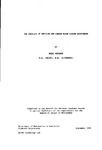THE RHEOLOGY OF UNFILLED AND CARBON BLACK LOADED ELASTOMERS
| dc.contributor.author | RUDDOCK, NIGEL | |
| dc.contributor.other | School of Engineering, Computing and Mathematics | en_US |
| dc.date.accessioned | 2013-11-05T13:16:30Z | |
| dc.date.available | 2013-11-05T13:16:30Z | |
| dc.date.issued | 1988 | |
| dc.identifier | NOT AVAILABLE | en_US |
| dc.identifier.uri | http://hdl.handle.net/10026.1/2610 | |
| dc.description.abstract |
This thesis is concerned with the use of rheological equations of state to describe the behaviour of vulcanised elastomers and, in particular, vulcanised elastomers loaded with carbon black. The properties of these materials are dependent upon the specific combination of elastomer and carbon black, and the effect of carbon black loading is studied by means of experiments on a butadiene-acrylonitrile base polymer KRYNAC 806, unfilled and loaded with 50phr SRF N774 carbon black. The first part of this work concerns small ampIitude oscillatory shear experiments carried out on a Weissenberg rheogoniometer over a range of amplitudes, frequencies, and temperatures. Both materials are found to remain within the linear viscoelastic region for temperatures greater than about -10°c, to obey the time-temperature superposition principle, and to have identical shift factors. Dynamic moduli over a reduced frequency range of about ten decades of log frequency are characterised by the Huet model. The second part concerns finite deformation experiments consisting of prestraining samples in simple tension and applying small axial oscillations when stress relaxation is almost complete. Dependencies of the incremental dynamic moduli measured in this way are investigated with regard to frequency and extension ratio. Moduli measurements indicate that the time dependence of the materials is unaffected by deformation, although relaxation spectrum functions for the filled sample are strain dependent. A criterion is established for testing whether results can be modelled by a certain class of non-linear viscoelastic constitutive equations. A constitutive equation is proposed which represents the strain dependence of moduli for both the filled and unfilled materials. Other published data are shown not to conform to the above criterion. It is also shown that despite this fact, in some cases at least, the proposed constitutive equation provides a better represent at ion of published data than other constitutive equations which have hitherto been applied. | en_US |
| dc.language.iso | en | en_US |
| dc.publisher | University of Plymouth | en_US |
| dc.title | THE RHEOLOGY OF UNFILLED AND CARBON BLACK LOADED ELASTOMERS | en_US |
| dc.type | Thesis | |
| plymouth.version | Full version: final and full version as approved by the examiners at the time of the award of your degree | en_US |
| dc.identifier.doi | http://dx.doi.org/10.24382/3266 | |
| dc.identifier.doi | http://dx.doi.org/10.24382/3266 |
Files in this item
This item appears in the following Collection(s)
-
01 Research Theses Main Collection
Research Theses Main


